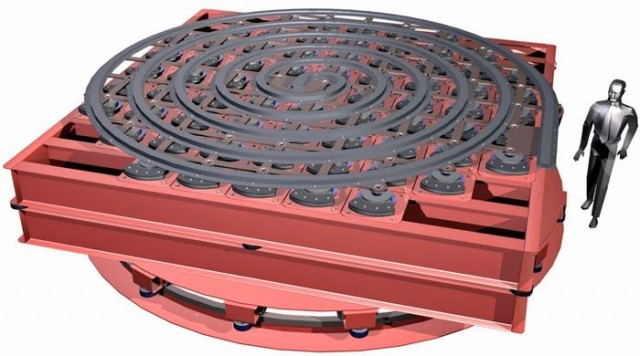Project Slingatron: launching cargo into space without using rocket engines

Rocket engines from the beginning of space exploration were the basis of the space program, but they were by no means the only path that was tried on this path. Since the 1950s, the American government has tested several ideas in this direction, from the space gun, which was tested in the 1960s, to the ideas of using the launch loop and the space elevator. When attempting to implement, most of these ideas encountered significant technical difficulties or were postponed for political reasons. But one team of scientists, hoping for the help of Kickstarter, expects to achieve those goals that turned out to be too tough for state structures.
The idea of the Slingatron project, like many other ideas, is theoretically workable. The idea is simple: rotating an object around a fixed point is the simplest way to reach high speed without excessive power consumption. There are two ways to build a classic slingatron: you can vary the rotation speed, keeping the path length unchanged, or you can change the path length, but keep the rotation speed constant. In both cases, the “thread” for launch will be broken long before the projectile reaches the first cosmic velocity.
')
The idea of the slingatron is simple - do not unwind the “thread” itself, but rotate the entire launch pad. It's hard enough to explain, but an analogy can help us in this case. Imagine you want to mix a cup of coffee. You can do this with a spoon, or you can also rotate the cup itself quickly. The centrifugal force will rotate the liquid around the walls of the cup, mixing the coffee thoroughly with minimal energy use.
The company HyperV Technologies Corp , which wants to raise money for this project through Kickstarter, has already built a prototype, which they claimed launched a projectile weighing about 200 grams at a speed of 100 meters per second. The purpose of the study is not to create a full-size model of the slingatron, but in a demonstration model that can launch a projectile weighing 400 grams at a speed of 1 km per second. Although this speed is not enough to launch a projectile into a near-earth orbit, this will be a significant step forward in future research.

You should not expect too much from this project, even if it is successfully implemented. Unlike rocket ships, the slingatron cannot be used to launch people into orbit or to launch large loads. But this method could be used to put into orbit small loads for astronauts - water, power, or equipment that will not fail due to the increased load at launch. But when using missiles, much of them are lost. Slingatron would not have such losses and could have thrown 10 kg weights literally every day into orbit.
The team hopes to collect $ 250,000 and build a prototype, which in the future will be able to reach speeds of 2 km / s. The prototype ( if money is collected ) will be in the form of a horizontal model with a diameter of 5 meters. It will allow to test the idea practically and give an answer whether it is possible to use such a system in real conditions with a payload.
Transfer.
Source text - http://www.extremetech.com/extreme/162252-slingatron-project-aims-to-prototype-new-space-launch-system
Project Slingatron on Kickstarter .
Source: https://habr.com/ru/post/187972/
All Articles